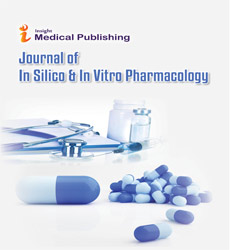Differentiation of Gestational Diabetes Mellitus Using Metabolic Plasma Study Based On Nuclear Magnetic Resonance
Emily D’souza*
Department of Silico & In Vitro Pharmacology, University of Exeter, Cardiff, Wales, United Kingdom
- *Corresponding Author:
- Emily D’souza
Department of Silico & In Vitro Pharmacology, University of Exeter, Cardiff, Wales, United Kingdom
E-mail: D_elimi.za@hotmail.com
Received date: December 03, 2021; Accepted date: December 16, 2021; Published date: December 23, 2021
Citation: Souza ED (2021) Differentiation of Gestational Diabetes Mellitus Using Metabolic Plasma Study Based On Nuclear Magnetic Resonance. In Silico In Vitro Pharmacol Vol:7 No:6
Commentary
Proton nuclear magnetic resonance (1H-NMR) spectroscopy was used to obtain metabolic profiles of the plasma, which were then examined using multivariate statistical data analysis. The link between demographic variables and possible metabolite biomarkers was investigated further. Metabolic patterns were similar in both the antepartum and postpartum groups. The levels of 2-hydroxybutyrate, lysine, acetate, glutamine, succinate, tyrosine, formate, and all three BCAAs (leucine, valine, and isoleucine) in the A2GDM group were significantly highert han those in the NGT group, and the levels of lysine, acetate, and formate in the A1GDM group were significantly higher than those in the NGT group. Both the A1GDM group and the A2GDM group had significantly lower levels of 3-methyl-2-oxovalerate and methanol. The severity of GDM may be reflected in metabolic profiles. Weight andp re-delivery BMI had considerable positive relationships with plasma BCAA concentrations. This research adds to our understanding of the pathogenesis and aetiology of GDM, which may aid in clinical management and treatment.
GDM is defined as hyperglycemia that occurs for the first time during pregnancy without a history of type 1 or type 2 diabetes. GDM that is not well controlled can have both short-term and long-term effects for both the mother and the fetus. GDM can cause difficulties in pregnant women, such as gestational polydhramnios, hypertension, infection, anda n increased risk of type 2 diabetes, cardiovascular disease [1-5], and female malignancies.
Dietary control and lifestyle adjustments are usually the primary line of treatment for women with gestational diabetes (A1GDM). However, if these methods fail to provide optimum gclyaemic ocntrol, insulin therapy (A2GDM) must be used. Many metabolic investigations on GDM have been undertaken using fluid and tissue samples, which has provided fresh insights into the development of GDM, although the distinction between the two subtypes of GDM has been seldom investigated. Because of the complicated pathophysiology of GDM, it is difficult to forecast the disease, and no single sign has been identified for high-specific screening in patients who fit the diagnostic criteria for GDM. We analysed the metabolic profiles of plasma from pregnant women with (A1GDM and A2GDM) or without GDM to characterise the metabolic profile of GDM from antepartum to postpartum with varying severity at various stages, which may be useful for understanding GDM pathogenesis and predicting its severity.
Surprisingly, the height of pregnant women reduced as the severity of GDM increased: women with A2GDM were substantially shorter than those with NGT. The severity of maternal diabetes rose as the mean gestational age at the time of birth decreased. Because they required ending their pregnancy sooner owing to pharmacological therapy or other therapeutic directives, A2GDM women's gestational age at delivery was much lower than normal pregnant women, resulting in premature delivery and the birth of a tiny for gestational age infant. The quantity of succinic acid, an important intermediate product of the Krebs cycle, was considerably boosted in the research of energy metabolism. The use of succinic acid (i.e., the disruption of the Krebs cycle) is thought to be prevented, resulting in insufficient energy supply. In order to gain energy, the cell must be supplied in various ways. When energy is insufficient to meet the body's needs, energy metabolism resorts to anaerobic glycolysis.
References
- Morgan M, Deoraj A, Felty Q, Yoo C, Roy D (2016) Association between Exposure to Estrogenic Endocrine Disruptors-Polychlorinated Biphenyls, Phthalates, and Bisphenol A and Gynecologic Cancers- Cervical, Ovarian, Uterine Cancers. J Carciong Mutagen 7:275
- Lyons RA, Benvenuti L (2016) Deposition and Distribution Factors for the Endocrine Disruptor, 4-Nonylphenol, in the Sierra Nevada Mountains, California, USA. J Environ Anal Toxicol 6:388
- Utku N, Pape UF (2016) Neuroendocrine Tumors. J Mult Scler 3:193
- Jahan S, Fariduddin M, Sultana N, Aktar Y, Hasan M, et al. (2015) Predictors of Post-Partum Persistence of Glucose Intolerance and Its Association with Cardio-Metabolic Risk Factors in Gestational Diabetes Mellitus. J Diabetes Metab 6:609
- Yanqiang W, Bingjun Z, Zhengqi L, Xueqiang H (2016) Neuromyelitis Optica Spectrum Disorders with Autoimmune Diseases. J Mult Scler (Foster City) 3:167
Open Access Journals
- Aquaculture & Veterinary Science
- Chemistry & Chemical Sciences
- Clinical Sciences
- Engineering
- General Science
- Genetics & Molecular Biology
- Health Care & Nursing
- Immunology & Microbiology
- Materials Science
- Mathematics & Physics
- Medical Sciences
- Neurology & Psychiatry
- Oncology & Cancer Science
- Pharmaceutical Sciences
